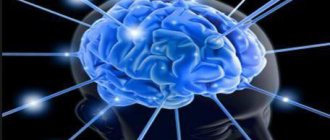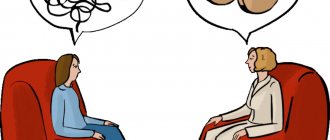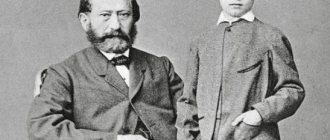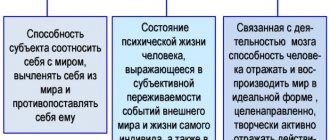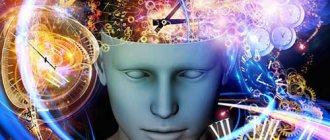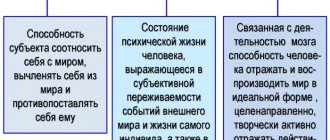Conscious mental processes
Definition 1
Conscious mental processes are those processes that are reflected in consciousness.
Consciousness is a person’s experience of events that occur in the external world. Consciousness is a function of the human brain. Thanks to consciousness, a person can receive ideas not only about the world around him, but also about himself. This function was formed in people as a result of evolution, but scientists have not fully figured out how this function was formed.
Conscious psychological processes are divided into three main groups:
- cognitive processes
- emotional processes
- volitional processes
Cognitive ones include:
sensations (this is a mental reflection of the characteristics of the surrounding world) representation (this is the reproduction of an image of some object or phenomenon from past experience) perception (a person’s subjective perception of the surrounding reality) memory (the accumulation, preservation and subsequent reproduction of knowledge) imagination (a person’s ability to build images in his mind, which were not perceived before) thinking (modeling of laws surrounding reality, the highest level of human cognition) attention (direction of perception towards some object or phenomenon, interests, needs, attitudes are responsible for attention, attention helps a person navigate the world around him) speech (form communication between people is built on the basis of language, on the one hand it is the process of reproducing thoughts, on the other hand it is the process of perceiving the thoughts of another person) reflection (a process during which a person concentrates on himself and his creation, on his interests, motives, values. In other words In other words, reflection is understood as a process when a person knows his knowledge and is aware of it.). The group of conscious psychological processes also includes emotional psychological processes:
The group of conscious psychological processes also includes emotional psychological processes:
- emotions (have an average duration, reflect a person’s assessment of situations in the objective world, have three main characteristics: reflected in the psyche, reflected in the systems of the whole organism, reflected in facial expressions, movements)
- feelings (reflect a person’s assessment of real and abstract objects)
- affects (an intense emotional process, short-term in duration, reflected in a person’s actions, as well as on the entire body as a whole)
- stress (the body’s reaction to unfavorable factors, can be neuropsychic and physical in nature.
Conscious psychological processes include volitional processes, such as:
- struggle of motives (this process is associated with the process of choice and determination)
- decision making (includes mathematical, statistical aspects, the study of the patterns of human choice)
- goal setting (a person’s understanding of his activities in terms of subsequent results)
What is an activity
Under activity
It is customary to understand the process of active interaction between a subject and an object of reality, in which the subject purposefully influences the object, achieving a goal and satisfying its needs.
Activities can be either constructive or destructive. Often both components are present, since often in order to create something, you need to destroy something first, and vice versa (for example, create a weapon to destroy the enemy army). The activity of a person or organization can be called any activity that is given a certain meaning - that is, the activity is somehow connected with the external world or the internal state of a person or organization.
Of particular importance for humans and animals is orientation-research activity, which became more and more diverse with the evolutionary complexity of organisms. This activity allows animals to survive, leave offspring and generally follow certain instincts, practically interacting with the outside world. Human activity is of a different nature, since the instincts in his psyche are abolished and in his life he is guided by the intellect.
Freud's unconscious
The Austrian psychologist and founder of psychoanalysis, Sigmund Freud, explaining the nature of the unconscious, cited the example of an iceberg. Thus, the conscious is only the tip, and its entire main part is unconscious processes.
Freud also believed that mistakes made by humans are not accidental. They arise when an unconscious intention “conflicts” with a conscious action. Errors are formed as a result of the predominance of unconscious desires over conscious ones.
As for the essence of dreams and daydreams, according to Freud’s theory, they also speak about a person’s unconscious desires and aspirations, about his unmet needs. In psychoanalysis, there are special methods designed to decipher dreams.
Freud developed a structure of the mind consisting of 3 levels:
- The conscious is the ego.
- Preconsciousness includes all human knowledge. If the information received is not needed by a person at the moment, then it is quickly forgotten. However, he can “extract” it if necessary. For example, if you ask a person what he ate for breakfast yesterday, a “folder” with this information will open in his head, and he will answer the question. He did not remember this throughout the entire time that had passed, but the information remained in his head.
- The unconscious stores all the most secret, terrible or, conversely, cherished thoughts and desires of a person, as well as unpleasant memories.
Unconscious
Previously, the human psyche was identified with consciousness. Sigmund Freud was the first to point out the enormous importance of the unconscious in human life and began to study it. Later, the idea of this area was expanded by Jung and Assagioli. The study of the area of the unconscious is still ongoing, and scientists are receiving new and interesting information.
Unconscious processes are those that a person is not aware of, but they influence his judgment, behavior and feelings.
In the human psyche, consciousness is only the tip of the iceberg, and the unconscious is its entire invisible part.
The unconscious is also called the subconscious.
It should be noted that consciousness and subconscious are inextricably linked. Images and ideas can move from one area to another. Thus, skills developed to the point of automatism cease to be conscious of us and pass into the realm of the unconscious. Rules of conduct, words heard from parents and educators in childhood, can develop into subconscious fears and attitudes that a person will not be aware of, but they will control his behavior.
Mindfulness and Long-Term Thinking
The main criterion for awareness is long-term thinking. The more awareness, the more clearly a person predicts the future.
In an unconscious state, a person does not see the consequences of his actions.
The most vile traitors always hide among unconscious people. Unawareness disables the manifestation of higher human feelings: empathy, love, altruism. The intellect suffers.
Instead, we get callousness, fear, self-centeredness and stupidity.
A person performs actions that he desires in the future. Their consequences are sometimes irreparable.
It always takes a long time for an unconscious person to “catch up.”
What is visible from the position of awareness, regardless of the health of the unconscious, becomes obvious in the unconscious itself only when its state changes.
Only consciousness can make a long-term forecast.
Me and my desires
Unawareness is slavery to your momentary desires.
Leading an unconscious life always leads to associating oneself with one's lower needs.
Awareness is the setting of one’s “I” over desires, which, most often, do not reflect our true essence.
This is an opportunity to put yourself above the system that is your body.
In a state of unconsciousness there is no “I”. What a person associates with his own personality is constantly changing.
A conscious person leads the body towards the realization of aspirations determined by the mind. Unconscious - driven by orders from different senses.
The true “I want” is determined only in consciousness!
But not in the unconscious.
The popular call “Do what you want” is perceived differently by the mind and the unconscious.
For example, a conscious person puts his “I” above immediate feelings. He understands that he wants to make his contribution to this world, develop, find love, create conditions for maintaining and improving his health, acquire a favorite activity, become a professional in it and earn a certain amount of money for a happy life. Needs may differ, but they are always global in the scale of human life.
The unconscious person comes to the conclusion that she needs to buy beer, eat ice cream, troll online, or get any other momentary thrill in accordance with the level of development of the unconscious.
Hedonism does not lead to happiness precisely because it is not conscious. It does not satisfy the true needs of the individual. In an unconscious state, you cannot even see them.
Manifestation of consciousness in human behavior
Manifestation of the conscious and unconscious in human behavior Read more: The concept of the unconscious
2 Manifestation of consciousness in human behavior
Human consciousness has a number of properties due to which a person’s reflection of the surrounding world is subjective. Such properties are: activity, selective nature, generality and abstraction, integrity, constancy, dynamism, distortion, individual character, ability to reflect, varying degrees of clarity. [10, 184]
The activity of consciousness is manifested in the fact that the reflection of the objective world is associated with activity, with an active influence on the surrounding world. The activity of consciousness is based on needs and interests. A child very early develops such needs as the need for communication, the need to understand the surrounding reality, and the need for action. A small child actively reaches for a toy hanging in front of him. If he fails to get her, he turns to his mother. He strives to understand the adults around him, who are so difficult for him to understand. His senses and the sensations associated with them develop even somewhat earlier than his movements. Needs do not remain static, they develop and change. New needs are also emerging.
Based on needs, the interests of people arise, which are also sources of activity of consciousness. Interest is understood as a certain conscious aspiration of a person towards a particular object that attracts him, or to a particular activity. Interest is always associated with a positive emotional attitude. Interest is a narrower concept than need, and less coercive. For example, we can talk about the need to acquire new knowledge and interest in some area of this knowledge. We can talk about temporary interests, interests in performing a given activity, and long-term, sustainable interests, for example professional interests.
The activity of consciousness is also closely related to the significance of those external influences that act on a person, to the significance of existing temporary neural connections and associations formed in the past, and to the significance of the person’s actions themselves.
So, for example, for a seven-year-old child who goes to school, the importance of learning is still far from being fully realized. He wants to study, because everyone studies, because this is the situation of a child of this age in our country. And that's enough for him. Gradually, year after year, he begins to understand better and more accurately the full meaning of teaching, and then of science in general. [6, 64]
The selective nature of consciousness is manifested in the fact that consciousness is directed not at the whole world as a whole, but only at certain of its objects (most often associated with some unrealized needs).
Generalization and abstraction means that consciousness does not operate with real objects and phenomena of the surrounding world, but with generalized and abstract concepts, devoid of some of the attributes of specific objects of reality.
The consciousness of a mentally healthy person, as a rule, has integrity. Within this property, internal conflicts of values or interests are possible. In some types of mental illness, the integrity of consciousness is disrupted (schizophrenia). [10, 185]
The constancy of consciousness is its relative immutability, stability and, most importantly, continuity, determined by memory. As a rule, “my consciousness” today is in many ways the same consciousness as yesterday. The constancy of consciousness is determined by mental states and especially personality traits.[7, 158]
The dynamism of consciousness, i.e. its changeability and ability for continuous development, determined by short-term and rapidly changing mental processes that can be fixed in the state and in new personality traits.
For example, previously people saw the sun rising above the horizon and concluded that the sun revolves around the Earth. However, after the discovery of Copernicus, we can already perceive the sunrise in a different way - as the rotation of our planet towards the luminary, that is, under the influence of logic, the primary cognitive processes change. [10, 187]
Distortion of consciousness. This means that consciousness always reflects reality in a distorted form, i.e. part of the information is lost, and the other part is distorted by individual characteristics of perception and personal attitudes. [10, 185] Distortion of consciousness can manifest itself in excessive suspicion, jealousy, love to the point of exhaustion, greed beyond measure, etc. negative traits in an individual's character. Distortions of consciousness include, for example, theft, bureaucracy, bribery, betrayal, alcoholism, drug addiction, terrorism, religious fanaticism. [3]
The individual nature of consciousness lies in the fact that the consciousness of each person is different from the consciousness of other people. This is due to a number of factors: genetic differences, upbringing conditions, life experience, social environment, etc. People evaluate events and their actions, the same objects of the real world, differently. Moreover, some people’s assessments are quite objective, i.e. correspond to reality, and the assessments of others, on the contrary, are extremely subjective.
The ability to reflect, i.e. ability for self-observation and self-esteem. A person is able to critically evaluate himself and his condition by placing the information received in a certain coordinate system. Such a coordinate system for a person is his values and ideals. He can also imagine how other people evaluate him. [10, 185]
The degree of clarity of consciousness. In consciousness there is a field (area) of clear consciousness - that which is constantly or periodically realized, is included in reflection, the desire to understand, understand, is brought to a clear understanding, assessments, conclusions, goals, plans, plans. There is also a peripheral field (area) of consciousness - the subconscious. What is located and happens in it is not actually realized for some time, but can be realized. Between the field of clear consciousness and the subconscious, mutual transitions are possible and occur. Well-mastered details of thoughts and actions—that which is automated—transfer from the field of clear consciousness to the area of the subconscious.
For example, a literate person writes without thinking about how to write out letters or combine them into words; the hand moves as if on its own, controlled by who knows what. When a person was a first-grader, under the guidance of a teacher, he consciously and diligently wrote out each letter in a notebook along squares and oblique lines. If you offer to tell a person how he does it now, he may, or maybe not, remember all the recommendations that he followed in the first grade, or he will independently tell you about the movements of his arm, hand and fingers.
Another example is human intuition, which is called a quick (instant) decision that requires lengthy preparation (B.M. Teplov). Before it was formed in a given person, he trained for a long time in an educational setting and in life on solving the corresponding type of problems. Receiving the initial data, he slowly, step by step, clearly aware, logically conducted mental reasoning until he came to a certain conclusion or decision. Gradually, with long exercises (often many years), intermediate clear reasoning shortened and accelerated, moving into the peripheral area of consciousness - the subconscious. When almost all of them move there, the possibility of intuitive conclusions, assessments, decisions arises: they arise immediately.
There are also opposite transitions. Vague impressions accumulate in the subconscious about what has been seen, experienced, and done in the experience of each person’s life. They have not yet been comprehended, not put in order, not systematized, not generalized, not brought to clearly understood and mentally formulated conclusions and decisions. This block of subconscious mental phenomena is like a storeroom in which there is great disorder and chaos. An intelligent, developed person, demanding of himself and striving to achieve success in life, periodically comprehends his experience, “draws out” what is in the subconscious, achieves a clear and distinct understanding, using the recommendations of science and wise, experienced, instructive people who have gone through life. In contrast, he is a careless person who lives for today, and is intellectually limited and does not do this. Devastation in his consciousness gives rise to devastation in his life. [8, 34]
Manifestation of the conscious and unconscious in human behavior Read more: The concept of the unconscious
Information about the work “Manifestation of the conscious and unconscious in human behavior”
Section: Psychology Number of characters with spaces: 34392 Number of tables: 1 Number of images: 0
Similar works
The relationship between the conscious and unconscious in the human psyche
24974
0
0
..., your thoughts and feelings, your actions, your place in society, in other words, awareness of yourself as a special and united person. Conscious and unconscious in the human psyche Along with conscious forms of reflection and activity, humans are also characterized by those that are, as it were, beyond the “threshold” of consciousness. A person’s mental activity, his psyche functions simultaneously in three...
Consciousness and unconsciousness in the human psyche and behavior
59133
3
0
... is, as N.A. Bernstein showed, “the transition of activity management to the subconscious level of regulation and bringing it to automatism.” Conclusion This work, “Consciousness and unconsciousness in the human psyche and behavior,” includes two chapters in its main content. The first chapter discusses the theoretical aspects of the study of consciousness and the unconscious mind. During their research...
Consciousness and unconsciousness
52220
0
0
... social experience, culture, spiritual values and the creation of these values by an artist or scientist, being accomplished in reality, do not always become the subject of reflection and in fact turn out to be a combination of consciousness and the unconscious. Therefore, at different times and in different countries there are many movements in fine arts and poetry. Each new historical era is uniquely reflected in...
Philosophy tickets (candidate minimum)
422218
0
0
... philosophy (fundamentals, problems, concepts).} 21. PHILOSOPHY OF EXISTENTIALISTS. (Camus. “Myth and Sisyphus. An Essay on the Absurd”, Sartre. “Existentialism is Humanism”). Existentialism - Philosophy of existence. Irrationalistic phil. The largest representatives: M. Heidegger, religious (K. Jaspers, G. Marcel,) atheistic (J.P. Sartre, A. Camus), N. Abbagnano. In Germ e. ...
Every day I get better and better in every way
For 30 days, every evening before going to bed and in the morning after waking up, sitting comfortably in bed and completely relaxed, closing your eyes, as you exhale, say the phrase 30 times: “Every day I am getting better and better in every way.”
When pronouncing a phrase, do not focus your attention on it. Mentally bending your fingers will help you count. It is not recommended to pronounce the phrase in an active waking state. Example: while driving, at work, at lunch. We accompany the repetition of the phrase with visual pictures of the fulfillment of what we want, that is, we turn on the imagination as much as possible, dream as much and as often as possible! WE ONLY THINK ABOUT THE GOOD! WE TRY TO THINK ABOUT GOOD AND IN AN ACTIVE, AWAKE STATE!
WE ONLY THINK ABOUT THE GOOD! WE TRY TO THINK ABOUT GOOD AND IN AN ACTIVE, AWAKE STATE!
I scrupulously followed the instructions and a miracle really happened, but not after 30, but after 40 days. I came to the realization of a rather serious problem that was located in the unconscious zone. After realizing this problem, I understood how this technique works and I want to share my thoughts with you.
The unconscious, from all the variety of constructs presented in it, selects the most significant problem.
The unconscious adjusts the cognitive sphere (perception, attention, memory, etc.) to extract the necessary information from the reality around us. The fact is that in this world everything we need is present (i.e.
resources, information, knowledge, etc.), but due to the selectivity of our attention, we often lose sight of very important details. Or even, this information is already in us, but hidden in the unconscious, i.e. is in some kind of abrupt, “collapsed” form.
The unconscious begins to scrupulously collect this information and put it into clusters and structure it. In this case, it should be noted that this process occurs automatically, i.e. without spending any effort.
Ultimately, when all the necessary information has been collected, insight occurs, the puzzle comes together, and the information is presented in our minds in the form of a structured image.
However, it should be noted that at the initial stages of awareness, the mood and general condition may worsen, this is due to the fact that the unconscious does not really want to part with its concept of the world, for it it may be somewhat painful, but then new information is built into the unconscious and acceptance is coming. published by econet.ru
Author Nadezhdin Sergey
Illustrations by Sofia Bonati
Thematic selections of videos https://course.econet.ru/live-basket-privat in our closed club https://course.econet.ru/private-account
We have invested all our experience in this project and are now ready to share our secrets.
- SET 1. PSYCHOSOMATICS: REASONS THAT TRIGGER DISEASES
- SET 2. HEALTH MATRIX
- SET 3. HOW TO LOSE WEIGHT ONCE AND FOR ALL
- SET 4. CHILDREN
- SET 5. EFFECTIVE REJUVENATION METHODS
- SET 6. MONEY, DEBT AND CREDITS
- SET 7. PSYCHOLOGY OF RELATIONSHIPS. MAN AND WOMAN
- SET 8.RESULT
- SET 9. SELF-ESTEEM AND SELF-LOVE
- SET 10. STRESS, ANXIETY AND FEAR
PS And remember, just by changing your consciousness, we are changing the world together! econet
Examples of human activity
It would seem that an active person is immediately visible. He can build houses, heal people, paint pictures, give lectures. We are accustomed to distinguishing an “active” from an “inactive” person by the presence of any benefit in his actions. But as a rule, by benefit we often understand only our own benefit or the benefit for those on whom we are dependent: we consider engaging in “state affairs” useful, although most often only civil servants benefit from them; in the same way, the serf once considered useful activities that satisfied the desires of his master.
We often call children who play too hard (often they can also be adults) slackers, although in reality this is incorrect. The game can bring enormous benefits to the players themselves, helping them develop some important knowledge and skills; and this, in turn, can further benefit others.
Thus, some specific human activity may not bring immediate benefit, but without it the existence of all mankind can be greatly complicated in the future. Let's imagine a primitive man who amused himself by throwing pieces of clay into a lighted fire. It would seem that he is doing sheer nonsense, instead of fulfilling the tasks of providing his tribe with food supplies and other necessary things. However, this “loafer”, with the help of his entertainment, discovered the basics of the production of dishes, bricks, tools, powerful weapons and other things that we cannot do without even in our time.
Sometimes the motives of a person’s life are hidden from the eyes of the observer and do not correspond to external manifestations. There are cases when overweight people came to work at a brick factory to lose weight. The parable of three people who moved stones is widely known; when they were asked what they were doing, the first answered: “I’m hunching over,” the second, “I’m making money,” and the third, looking up at the sky, said, “I’m building a temple.” Outwardly, they were doing the same work, but the ultimate goal of these actions was different for each of them.
Even a person engaged in “imitation of vigorous activity” is still active, because his actions have a very definite meaning (usually this is hiding from his superiors his incompetence, fundamental reluctance to do this work, or laziness).
Currently, information is an extremely important type of human activity. Substantial financial and material resources are being invested in various occupations of this kind, while funding for many other professions is decreasing. However, the real significance of “information” professions is not the same: obtaining and publishing scientific knowledge, for example, has a pronounced social significance, but the production of advertising is mainly aimed only at obtaining personal gain. The production of useful information is adjacent to the production of “information noise”.
Unconscious motivators of conscious actions
The speed and accuracy of a person’s response to any stimulus depends on the skill of performing certain actions, so skill and attitude are in many ways the same thing. However, the skill manifests itself during the implementation of the action, while the attitude refers to the period preceding the implementation of the action.
Installation types:
— motor installation (readiness to perform a specific action),
— mental attitude (readiness to solve intellectual problems using known and accessible methods),
- perceptual attitude (readiness to perceive one thing and ignore another).
An attitude is also automatism, only automatism in the motivational sphere of a person; it is a preliminary adjustment of the body to perform certain actions. As a result of a whole series of experiments, D. N. Uznadze and his colleagues came to the conclusion that the installation is truly unconscious.
Interesting experiments were conducted with the formation of attitudes in subjects during hypnotic sleep: they were told, for example, that after some time they should go to a hanger and put someone else’s hat on their head. When the subjects actually did this, they were asked about the motives for this “strange” act. The subjects responded by coming up with all sorts of excuses.
Subject and principle
Any activity is not pointless; it is always aimed at something or someone. According to scientists, there are 2 main principles: functionality and consistency.
In the first case, a person starts from already formed elements in the psyche and actively uses resources to achieve the goal. In the second case, the activity is influenced by the personal qualities of the subject, since the structure of the activity is quite extraordinary. With the help of psychological activity, one can understand the essence of the functioning of the human personality, as well as its properties.
Unconscious mental processes
There are many mental processes that are not consciously recognized by the individual. These processes belong to the group of unconscious processes.
Note 1
Unconscious psychological processes differ from conscious ones in that a person is not able to independently control them.
The topic of unconsciousness is studied not only by psychologists, but by representatives of other disciplines, for example, philosophy, law, and psychiatry. But at the moment, despite the large number of studies carried out in various fields, only a small amount of information is available to scientists.
Unconscious mental processes are divided into three groups:
- unconscious mechanisms of conscious actions
- unconscious motivators of conscious actions
- "supraconscious" processes
Unconscious mechanisms of conscious actions include three subclasses:
- unconscious automatisms
- unconscious attitude phenomena
- unconscious accompaniments of conscious actions
Unconscious automatisms mean actions that are performed as if “by themselves.” For example, mechanical work that does not require stress on the brain. When our brain does not experience stress when performing work, this means that during this action the control of consciousness over this action is lost.
This group is also divided into:
- primary automatisms
- automated actions or skills
Primary automatisms are actions that are formed in a person at birth or were formed in the first year of life.
The second group includes processes that were initially conscious, but as a result of repeated repetition, became mechanical and unconscious.
Note 2
But it should be noted that when we perform unconscious automatisms, we still understand what we are doing, this indicates that consciousness is not homogeneous.
The phenomenon of unconscious attitude is a very important concept in psychology. An attitude is a person’s readiness to take an action.
Psychologists believe that skill and attitude are one and the same. But a skill appears while a person performs actions, then the attitude precedes the action. There are different settings:
- motor installation
- mental attitude
- perceptual attitude
Unconscious attitudes are important for conscious actions. Unconscious accompaniments of conscious actions are the third subclass of unconscious mechanisms
There are a large number of unconscious processes that simply accompany the action.
Unconscious accompaniments of conscious actions are the third subclass of unconscious mechanisms. There are a large number of unconscious processes that simply accompany the action.
We include involuntary movements, tonic tension, facial expressions and pantomime, as well as a large class of vegetative movements as involuntary accompaniments of conscious actions.
Another larger class of unconscious processes is the unconscious stimuli of conscious actions. Those actions that a person carries out unconsciously have a meaningful nature. Human behavior is governed by drives and desires. These drives and desires may be hidden deep in the subconscious, but can still control a person's behavior.
The third group includes “supraconscious” processes. Scientists include in this class what is formed as a result of strong conscious work, for example, when a person is engaged in solving a complex task assigned to him. A person first analyzes, selects possible options for solving this problem, and then the person comes to a solution to the problem assigned to him. The very process of the emergence of a solution remains unconscious to us. In other words, it is called intuition.
Activity
Activities in social science are a set of actions aimed at transforming the surrounding reality to achieve certain goals. At the same time, a person is able to create a comfortable environment for his own existence.
There are two components of any activity: subject and object.
- A subject is a person (less often a group of people) performing an action.
- Object - an object or person experiencing the actions of the subject.
The subject can be an individual, society as a whole, or an organization. An object is most often an inanimate object. The object can also be another person or a living being (for example, during communication).
The same person can be both a subject and an object at the same time (for example, when an athlete improves his own body).
Unconscious contents of the psyche
The category of the unconscious includes a variety of mental processes that have different names within the framework of different theoretical concepts. First of all, these are mental processes associated with automated behavior controlled under the cortical structures of the brain. This includes numerous signals coming from internal organs, joints, muscle spindles, skin surface, receptors throughout the body, the insignificant strength of irritation of which does not allow them to become a priority and be recognized. P.V. Simonov gives p uc . ll . l .
m. Frank.
Dwelling (Science. 1998. this group of mental phenomena May/June). the name is preconscious.
251
Patients who lose consciousness during surgery often report later that at that moment they heard doctors talking about their condition, felt the pressure of the needle with which drugs were injected, but could not move or communicate with others. Their memory was capable of retaining information about these events.
The unconscious also includes those phenomena that were once conscious and can be conscious again under certain conditions, but are currently not included in the sphere of consciousness. Indeed, every person at different moments in life is aware of a wide variety of information. Having ceased to be a priority, it does not disappear forever, but persists and waits in the wings. Moreover, it can participate in regulating human behavior without entering the realm of awareness. These unconscious contents are called preconscious
within the framework of the psychoanalytic concept and
the subconscious
according to the classification of P.V. Simonova.
And finally, the unconscious refers to the unconscious -
central concept of psychoanalytic theory. By definition, the unconscious is that part of the psyche whose contents cannot become conscious without the use of special (psychoanalytic) techniques. It includes instinctual desires, emotions and repressed thoughts (Figure 11.2).
The structure of the unconscious is absent in the concept of P.V. Simonov, but there is another structure in it - superconsciousness, or intuition. It, unlike the subconscious, devoid of creativity, is a source of new hypotheses and discoveries.
The division of the psyche into consciousness and unconscious processes raises the question of how information is translated into the category of conscious or unconscious. If for automated behavior and preconsciousness the reason for being outside consciousness may be the lack of priority or weakness of impulses (Libet, 1991) (this mechanism will be discussed in Chapter 12), then in the case of the unconscious, from the point of view of psychoanalysis, consciousness has special reasons not to allow its contents to become conscious.
Types of human activities
All types are divided according to the method of implementation into material (practical) and spiritual.
- The practical form includes the transformation of the material, material world (nature and society). For example, the production of goods or construction. Practical activities are divided into: Material and production - the object is nature, and the result is material goods.
- Socially transformative - the object is society, and the result is a change in social relations.
Its subspecies include:
- Cognitive activity, the result of which is knowledge.
Value-oriented, as a result of which a person’s worldview is formed.
These types are interconnected (practical and spiritual).
For example, the results of spiritual activity (music, scientific achievements) are captured using a practical form (printing notes, publishing books). Well, the practical form, in turn, is impossible without the spiritual (idea).
Another classification of activities is based on the ways of forming a person as an individual. Psychologists have identified several types of activities.
- Gaming – the leading activity in children, there is no goal as such (the process itself is important), is a way of understanding the world. In the game, through imitation of reality, knowledge of the environment is carried out. It is conditional in nature (imaginary situations are played out), but certain rules and norms are followed.
This is the only type of activity that is characteristic not only of people, but also of animals. - Academic – acquiring skills and discovering abilities that will help you live a happier, more comfortable and successful life. Studying may not always be purposeful. Often a person acquires knowledge spontaneously (from TV, movies, books, the Internet). The student does not create new knowledge, but only masters existing knowledge.
- Labor is the interaction of a person with the outside world, aimed at creating a socially useful product (material and spiritual) that helps improve the standard of living of society.
The components of labor are the knowledge and skills of a person, as well as his skill. Work is carried out out of necessity, but at the same time transforms the world around us. It is aimed at obtaining a socially useful result, in contrast to a game in which the main thing is the process. - Communication activities are aimed at the exchange of information, emotions, feelings, assessments and specific actions.
The peculiarity is that it requires a partner (an equal subject of communication) and the use of speech (language). Communication helps a person become an individual, develop communication skills, express himself, gain new knowledge (this type is present in all others). - Creative – any type of activity that leads to a unique result (the creation of something qualitatively new).
It is distinguished by uniqueness, originality and uniqueness of ideas. Important components for creativity are intuition (anticipation of the result), imagination and fantasy. Creativity is included in almost all types of human activity, as well as communication.
Mindfulness and Love
A person confuses love with a lot of other states. Sympathy, love, emotional dependence, habit, sense of ownership. All this in popular culture is called love.
But love does not exist in an unconscious state. Feelings pass quickly, as they are an element of the unconscious perception of another person.
Love is a conscious renunciation of selfishness in favor of another person.
And this is a completely different level of feeling.
The less aware a person is of himself, the less true love he has.
Therefore, if you strive to find love, first try to gain awareness.
Lack of awareness is fixable
For everyone who recognizes themselves in the description of an unconscious person, there is good news: it can be fixed!
We all go through a phase of unawareness during childhood. The child does not think in terms of long-term goals; he is not able to understand the true reasons and meanings of his actions.
While consciousness has not yet developed in the little man, his survival is ensured by his parents.
An adult cannot afford to remain unconscious. However, each of us is, to one degree or another, susceptible to unconscious states. You just need to work through them without reproaching yourself for wrong actions or thoughts.
Developing mindfulness is hard work. But it always pays off by achieving higher tastes in life.
The role of the unconscious in human life
The unconscious is guided by principles of pleasure that have no relation to reality and time.
The unconscious manifests itself in a person's daily life in many things. For example, this could be a slip of the tongue when communicating with people. It often contains a person’s true thoughts and motives, which he diligently hides. It slips when unconscious aspirations collide with conscious goals of behavior, which ultimately creates contradictions with disguised true motives.
The fact that a person forgets the names of others is also an example of the unconscious. We don't remember a person's name unless we consider it the most important and significant. It takes us a long time to retrieve information about his name from memory, and this process of remembering occurs against our will.
Each of us performs certain unplanned movements, brought to the point of automaticity. At first they are performed consciously, then they are consolidated in the subconscious and become part of the unconscious. These include:
- reading;
- writing ability;
- acquisition of speech skills;
- ability to walk.
Having brought these actions to automaticity, after time has passed we do not have to turn on consciousness when performing them.
Dreams are another form of the unconscious. They express our true thoughts, fears, cherished desires, and feelings. They are not always specified and can be expressed through symbols.
Examples
An example of conscious activity is any goal-directed behavior based on emotional interest in achieving a goal and the use of will.
For example:
- admission to a university to obtain a diploma in the desired specialty.
- systematically going to the gym to improve your physical fitness,
- attending interviews for the purpose of employment for the desired job,
- following a diet to reduce weight to the desired level,
- taking advanced training courses to get promoted up the career ladder,
- courting a girl with the aim of entering into a relationship with her, etc.
Unconscious automatisms
The processes included in the subclass of unconscious automatisms are of a dual nature:
- never realized before (fundamentally not realized),
- once conscious, but at the moment occurring automatically (skills).
Examples of fundamentally unconscious ones: a child’s sucking movements, blinking, eye convergence, grasping objects, walking and much more. Examples of skills: playing a musical instrument, writing, speaking a foreign language, and an endless number of other skills.
It is worth noting that psychologists distinguish in the structure of consciousness:
- focus of consciousness (the most important thing at the current moment in time),
- periphery of consciousness (weak control by consciousness is exercised),
— the boundary of consciousness (the processes located here can either leave the field of human consciousness or enter it),
- unconscious.
Developed skills usually “balance” on the border of consciousness. If a person begins to make a lot of mistakes (when tired, for example, or when the activity becomes more complicated), then the skill again falls into the field of consciousness, to its periphery or even into focus. The skill is controlled, improved, and then returns again to the border of consciousness. This is what distinguishes skills from fundamentally unconscious processes, in that they “wander.”
Various examples of automatisms:
- when reading any text fluently, we do not think about the outline and meaning of individual letters, but “immediately” perceive the meaning of what we read,
- a radio operator working with Morse code, perceiving the sound of short and long signals, completely freely translates them into a logical combination of letters and words,
— entering a dark room, the hand “itself” reaches for the switch.
Dictionary of antonyms
CONSCIOUSNESS - UNCONSCIOUSNESS
Consciousness of actions - unconsciousness of actions.
CONSCIOUSNESS - UNCONSCIOUSNESS
Tatyana suddenly decides to write to Onegin: the act is naive and noble, but its source lies not in consciousness, but in unconsciousness: the poor girl did not know what she was doing.
Belinsky. Works of Alexander Pushkin. People always love through something: through a word or through silence, through explosive passion or through restrained and subtle lyrics, through subordination or subordination of oneself, through the flesh or through the spirit, through consciousness or through unconsciousness, through similarities or through differences, and so on. further, and so on. Zalygin. After the storm. CONSCIOUS - UNCONSCIOUS Conscious - unconscious consciousness - unconsciousness consciousness - unconsciousness conscious - unconscious consciously - unconsciously consciousness - unconsciousness conscious - unconscious consciously - unconsciously awareness - unconsciousness conscious - subconscious consciously - subconsciously
Conscious efforts - unconscious efforts.
Ο Observing any act of memory, we will certainly notice in it a conscious element: we are aware of what we remember, and an unconscious element: we are not aware of what is stored in our memory. Ushinsky. Educational anthropology. One such conscious fighter is worth more than a hundred, albeit daring, but unconscious brave men. Furmanov. Conscious heroes. ~ In meaning noun Wed R. We know very well to what extent mental mental life is variegatedly composed of the conscious and the unconscious. I. Pavlov. Pavlovsk environments. But we will simplify the situation if we do not notice that Suvorov’s conscious often changed places with the unconscious. Lotman. Conversations about Russian culture. CONSCIOUS - UNCONSCIOUS
Conscious actions - unconscious actions.
Ο Behind this kind of attitude towards his biography as a writer, Astafiev sees a conscious or unconscious desire of critics to ensure that “the reader is as lenient as possible towards me.” F. Kuznetsov. I am responsible for everything. CONSCIOUS - SPONTANEOUS Conscious - spontaneous consciousness - spontaneous
Conscious actions - spontaneous actions.
Ο A realist is always a dialecticist by nature, conscious or spontaneous. Pudovkin. Realism, naturalism and Stanislavsky’s “system”. After the war, a rise in spirit is very possible. But it is required that this rise be conscious, and not spontaneous. M. Gorky. Letter from S.V. Malyshev, May-June 1915. CONSCIOUS - MACHINAL Conscious - mechanical consciousness - mechanicalness
Out of mechanical habit, the dog tucked its tail between its legs when it ran away from you, but it ran out of a conscious thought. Chernyshevsky. Anthropological principle in philosophy.


